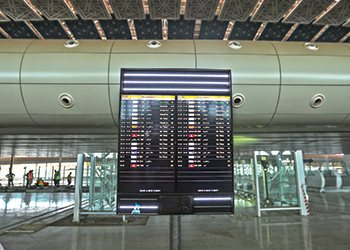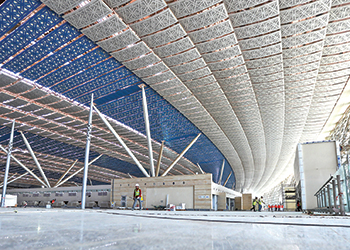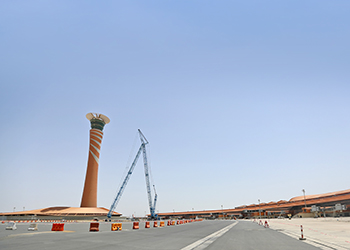Partners in progress
01 July 2017
In what is seen as a bold step, Saudi Arabia has continued on its path to privatisation of its aviation sector with the award of four new BOT contracts.
Saudi Arabia has taken another giant step towards privatisation of its aviation sector with the recent signing of key contracts for four airport projects on a build-operate-transfer (BOT) basis.
The contracts for the Taif, Qassim, Yanbu and Hail airports have been awarded on a BOT basis, according to Saudi newspaper reports. Once completed, these airports will have a total capacity to handle more than 19 million passengers per year.
In addition, Saudi Arabia’s General Authority of Civil Aviation (GACA) has signed a contract with Singapore-based Changi Airports International (CAI) to operate the new King Abdul Aziz International Airport (KAIA) in Jeddah – which is currently under construction – for a 20-year period, reported Arab News, citing the transport minister.
 |
Sulaiman Al Hamdan said the contract to develop and operate the new Taif International Airport was signed with Asyad Holding Group in collaboration with Consolidated Contractors Company and Munich Airport. The airport in the northeast Taif province – Saudi Arabia’s fifth international airport – will act as a new gateway for Haj and Umrah and will able to receive five million passengers annually, eventually reaching eight million. The airport, which is expected to open in 2020, will start operations with one 4,300-m runway able to accommodate the superjumbo A380 jet, although two runways will be taken into account during the design phase.
The contracts to operate Qassim’s Prince Naif bin Abdulaziz Airport, Hail International Airport and Yanbu’s Prince Abdul Mohsin bin Abdulaziz Airport were signed with the consortium of Turkish TAV Airports Holding and Al Rajhi Holding Group.
Al Hamdan, who is also the chairman of GACA, said these contracts are in line the authority’s strategy of expanding the private sector’s role in airport projects and increasing investment opportunities to provide the best services to passengers, to international standards.
Following Saudi Arabia’s success with privatisation of the Prince Mohammed bin Abdulaziz International Airport in Madinah, Hamdan indicated that partnering with the private sector will contribute to the development of these airports. The Madinah airport is being operated by Tibah Airports Development, the ownership of which is equally split between TAV and Al Rajhi Holding.
Other airport projects on the anvil include one at Qunfudah. The new economic airport in the north of Makkah province is also likely to be built on a BOT basis. Work will soon start on the planning and design of the project.
 |
KAIA ... highly sophisticated. |
Jeddah airport
Meanwhile, work on the new state-of-the-art KAIA airport in Jeddah is 88 per cent complete and the airport will start test operations early next year, according to GACA.
As many as 21,000 engineers and workers belonging to 110 companies are racing against time to complete the first phase of the project, the Saudi Gazette quoted Ibrahim Mandoura, director general (planning and studies) of GACA, as saying.
Following the completion of the SR27-billion ($7.2 billion) project, KAIA will become one of the largest aviation hubs in the world. It will be a smart, environment-friendly, unique landmark of the Arab and Islamic architecture.
Located 19 km north of Jeddah city, the airport boasts one of the tallest control towers in the world, with a height of 136 m. In the first phase, the airport will handle 30 million passengers per annum.
“With the completion of the second phase, the airport will be able to handle 55 million passengers, and 100 million following the third and final phase. So far, 88 per cent of the works has been completed and the airport would serve 36.5 per cent of the total passengers using Saudi airports,” he said.
 |
KAIA will handle 30 million passengers in its first phase of development. |
Spanning an area of 810,000 sq m, the airport complex will have two new terminals for domestic and international passengers, allowing all airlines to operate under one roof. It includes passenger lounges, a new concourse building with 25 additional passenger bridges and connector buildings linking the terminals, air bridges and movable gates, apron and taxiway modifications and extensions, electrical and mechanical systems and extension.
A total area of 27,987 sq m has been earmarked for commercial investment purposes.
The terminal consists of 220 standard check-in counters for all airlines, 80 self-service kiosks for airlines, 56 passport control counters for departures and 72 counters for arrivals, 117 passport self-service machines, 46 gates for domestic and international passengers, 94 aerobridges, 42 waiting lounges for international flights and 24 for domestic flights, four waiting lounges for senior citizens, five lounges for first class and business class passengers, and an automated shuttle system for the transport of international passengers.
The public transport centre is another major highlight of the new airport. The integrated centre is situated between the airport terminal complex and the multi-storey car-park. The terminal is linked with the parking areas, Haramain station, metro station, taxi and bus stations.
Riyadh airport
Construction work is also under way on the upgrade of two terminals at King Khalid International Airport in Riyadh. A Hochtief-led consortium is working on the $1.46-billion contract from GACA to redesign, upgrade and expand terminals Three and Four, the demolition and reconstruction of the aprons, construction of terminal lounges and operation buildings, and installation of baggage handling and security systems. The consortium includes Shapoorji Pallonji Mideast and Nahdat Al Emaar.
The project is the first phase of a $4.5-billion programme by GACA to develop and expand the airport’s facilities.
- Partners in progress
- January launch for Duqm airport
- TAV flies high in region
- Digitalisation focus of key expo
- ACO drains preferred
- Thales and Sita get Bahrain job



